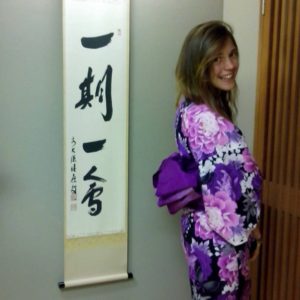
Your name: Louise Thiaville
Where are you based: Sendai, Japan
What do you do: I am doing a PhD about the growth of rice plants, when they are still very young. I am especially interested in their “strategy” and “learning” (yes yes!): how do they recycle their own resources, and where do they allocate them, depending on their environment ? The rest of my time pretty much revolves around tea: drinking some with friends and by myself, practicing chanoyu, following the leaves until the tea fields… and dreaming about it, awake or asleep!
Please briefly introduce yourself. What is your story with tea?
Tea has always been part of my life – I certainly had matcha latte in my baby bottle -, first as a pleasant everyday drink. I realized how fun and diverse tea could be during junior high school, when I lived for a few months in Uji. Several years later, as I started practicing chanoyu, I was offered koicha; the flavors, texture, color… almost too delicious to be true! From then, my taste for tea and a generous pinch of luck led me to meet tea enthusiasts and farmers, in a dorayaki café in Paris or tea fields in Japan.
Why did you want to get involved with GJTea?
One of the most precious gifts that tea keeps offering me is the occasion to connect: to friends already dear to me or persons I do not know (yet), to tea fields and by extension to Nature, to tea farmers and chanoyu sensei who keep nurturing tea cultures. But there are so many layers in Japanese tea, that even though I want to contribute and give back, I generally have no idea where I could start! When I met Simona and Matsu in Europe, they told me about GJTea’s project to reconnect different pieces of the Japanese tea world… Bingo !
In collaboration with GJTea what has been your role so far?
In terms of collaboration, I simply did a bit of translation for the website, in sections providing general information about Japanese tea in French. And very recently, I had the chance to participate to the public global Japanese tea party… and share tea online, with people all around the world!
What is your favourite way to make tea?
I probably wouldn’t be able to choose a specific method to make tea, and the question gets even harder if I have to pick a favorite tea or teaware! To still give some kind of answer, the moment I cherish most would be sometime in the morning, and the place, somewhere outside. I would then be able to choose a tea based on the season, weather, and my hopes for the day. And if this tea reminds me of someone or a place I like, even better!
When did you start liking tea?
Probably the first time I tried it (?), when I was a kid… and realized that it made water so much tastier! It is quite ironic that I now enjoy a glass of water, especially after tea – you can feel some of the aromas come back, a bit like a second wave of aftertaste.
How did you discover Japanese tea?
The first teas I had as a kid – all jokes about baby bottle aside – were probably Japanese teas, given to my parents as omiyage. My parents lived for a year in Japan, and when they came back to France, their friends would either bring or send us Japanese teas. That Japanese tea came to my life is just a happy coincidence, but I feel that the way it came isn’t: talking to tea friends, but also considering how tea arrived in Japan, the importance of tea gifts is everywhere!
Where do you look for Japanese tea?
I guess in a way, I am looking for Japanese tea anywhere and anytime. I really like to come across teas unexpectedly, or to discover teas that I did not know or do not correspond to my “usual” preferences. But the places I love for tea have just one thing in common: the persons growing, making, serving or selling it sincerely like their tea. I love to go to tea fields, factories, tea-related events, and buy teas both online or in my favorite local tea shops!
What are your tea-related dreams for the future?
Even though I still know so little about tea and Japan, I somehow deeply care for both of them. My dream would be to connect the different worlds of tea, notably in Japan. I am of course thinking of people at both ends of the tea production chain – producers and consumers -, but also considering the social worlds they live in – such as tea farming and chanoyu. Bridging these gaps could show producers how much happiness they bring, reinforce the environmental perspective in tea practices, and overall add an individual feeling of true meaning and freedom when one hears “tea”.
Your message to fellow tea enthusiasts:
I will share a reflection by Soshitsu Sen XV, former iemoto (head) of Urasenke, from the book Tea Life, Tea mind: “Tranquility [is] an aesthetic concept unique to tea. […] But, strange to say, this tranquility will deepen even further when another person enters the microcosm of the tearoom and join the host in contemplation over a bowl of tea”. Even though this originally refers to chanoyu practice, this exquisite tranquility came over and over again when sharing tea with friends, even in difficult times or when this other person was a cheeky breeze blowing matcha powder. Let’s share tea!
Thank you Louise!
